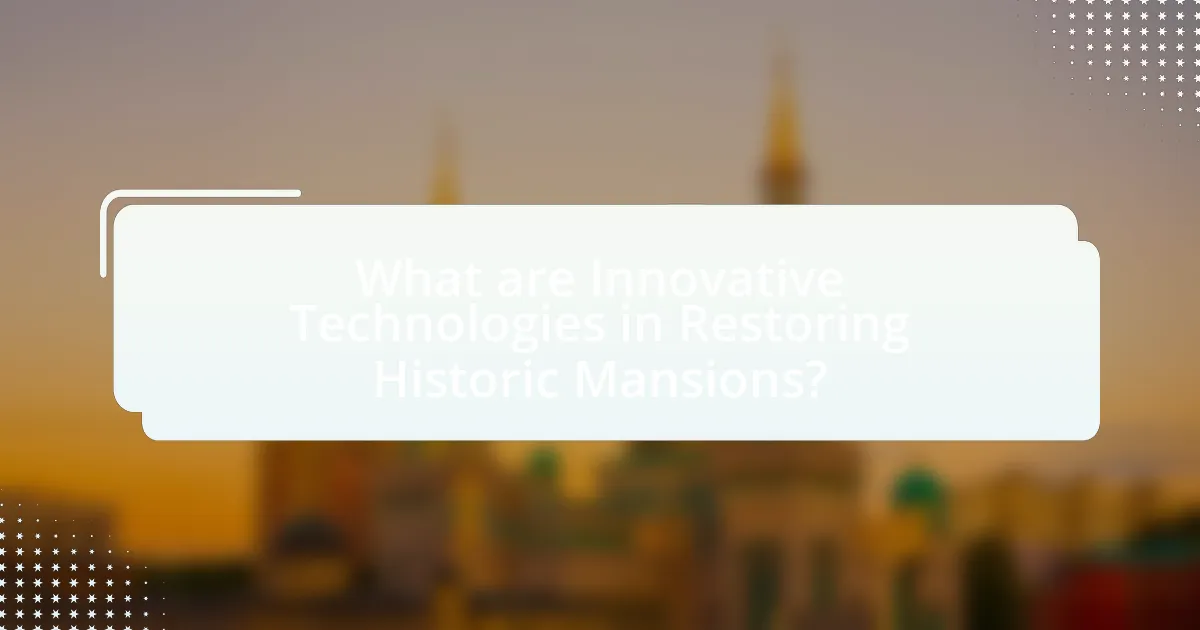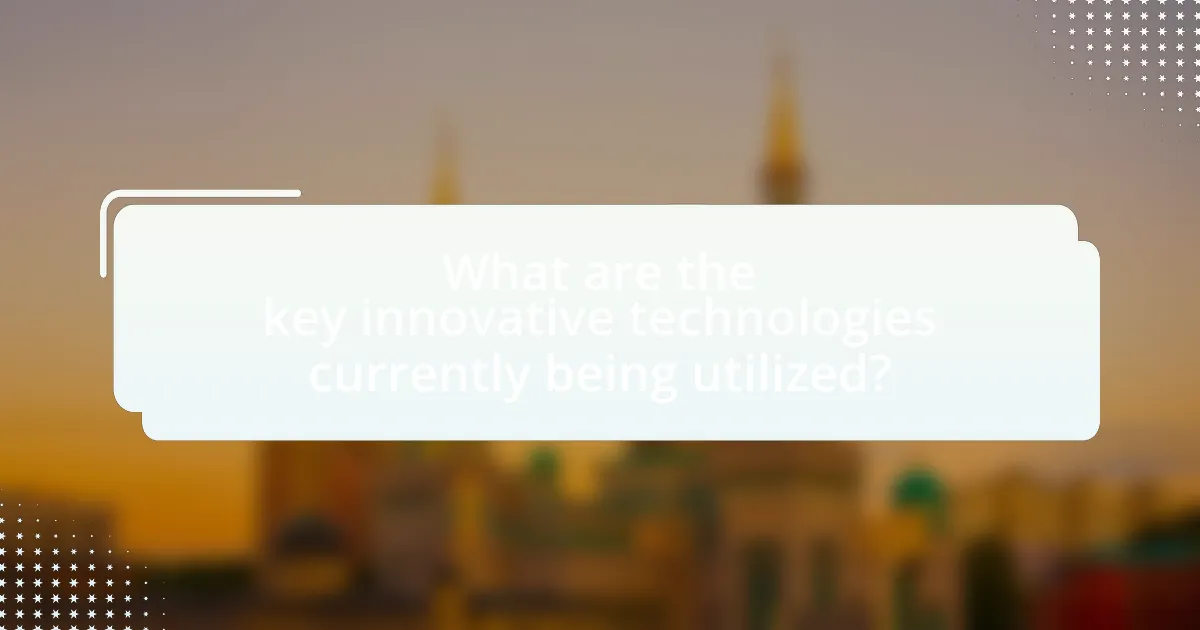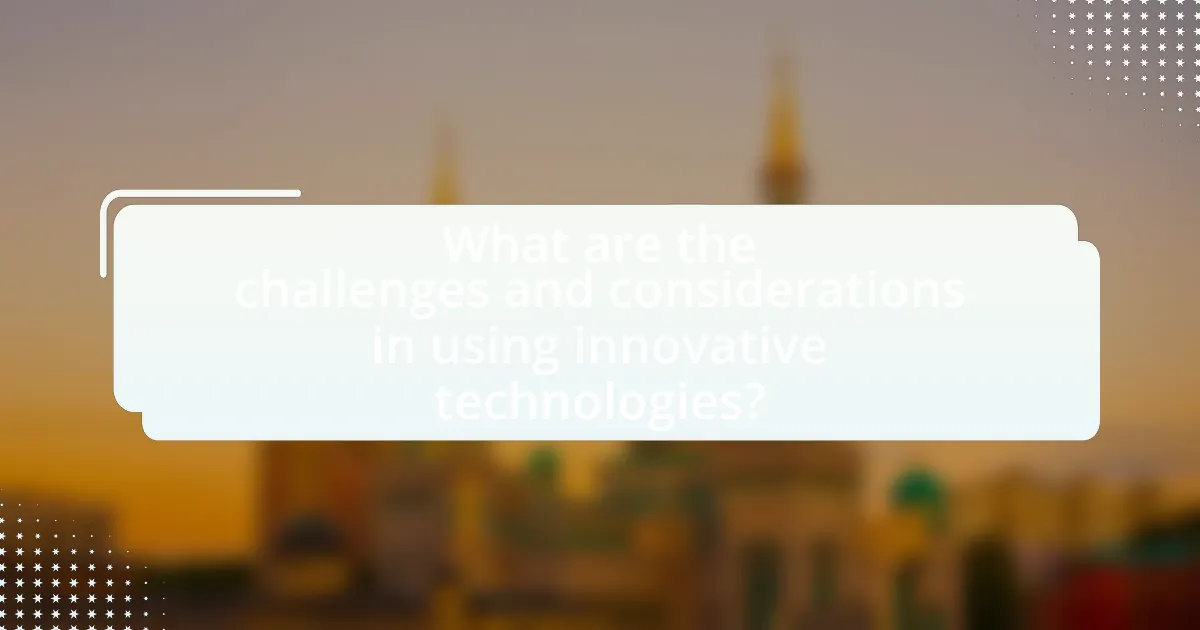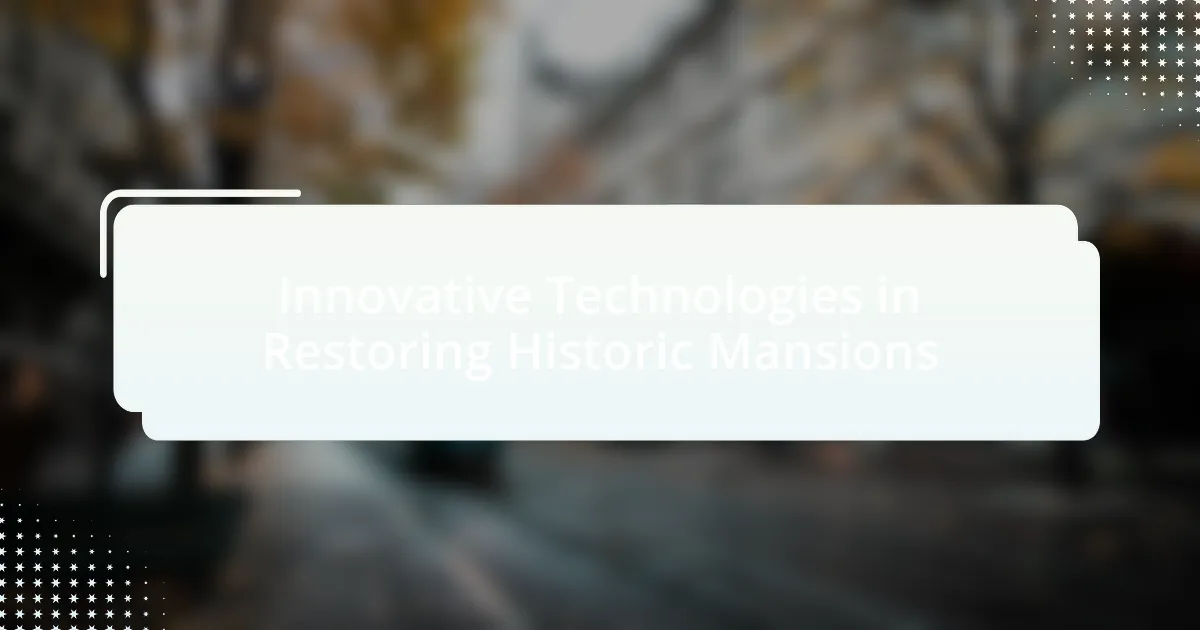Innovative technologies in restoring historic mansions encompass advanced methods such as 3D scanning, Building Information Modeling (BIM), and the use of nanotechnology-based materials. These technologies enhance the accuracy and efficiency of restoration projects by providing precise documentation, facilitating collaboration among stakeholders, and ensuring the preservation of original architectural features. The article explores how these modern techniques differ from traditional restoration methods, their benefits for sustainability and historical integrity, and the challenges faced in their implementation. Additionally, it highlights best practices for integrating technology with traditional restoration approaches to maintain the authenticity of historic structures.

What are Innovative Technologies in Restoring Historic Mansions?
Innovative technologies in restoring historic mansions include 3D scanning, Building Information Modeling (BIM), and advanced materials like nanotechnology. 3D scanning allows for precise documentation of existing structures, capturing intricate details that inform restoration efforts. Building Information Modeling enhances project management by creating digital representations of the mansion, facilitating collaboration among architects, engineers, and preservationists. Advanced materials, such as nanotechnology, provide solutions for repairing and preserving original materials without compromising their integrity, ensuring that restorations maintain historical accuracy while improving durability. These technologies collectively enhance the efficiency and effectiveness of restoration projects, preserving cultural heritage for future generations.
How do these technologies differ from traditional restoration methods?
Innovative technologies in restoring historic mansions differ from traditional restoration methods primarily through their use of advanced materials and techniques that enhance precision and efficiency. For instance, technologies such as 3D scanning and printing allow for accurate replication of architectural details, which traditional methods may struggle to achieve due to limitations in manual craftsmanship. Additionally, modern materials like carbon fiber and advanced adhesives provide stronger and more durable solutions compared to conventional materials, which can degrade over time. These advancements not only improve the structural integrity of restorations but also reduce the time and labor costs associated with traditional methods, which often rely heavily on manual labor and less precise techniques.
What specific innovative technologies are commonly used?
Innovative technologies commonly used in restoring historic mansions include 3D scanning, Building Information Modeling (BIM), and advanced materials like nanotechnology-based solutions. 3D scanning allows for precise documentation of existing structures, enabling accurate restoration plans. BIM facilitates collaboration among architects, engineers, and contractors by providing a digital representation of the building’s physical and functional characteristics. Advanced materials, such as nanotechnology-based solutions, enhance durability and energy efficiency while preserving the original aesthetics of historic structures. These technologies collectively improve restoration accuracy, efficiency, and sustainability.
How do these technologies enhance the restoration process?
Innovative technologies enhance the restoration process by improving accuracy, efficiency, and preservation quality. For instance, 3D scanning and modeling allow for precise documentation of existing structures, enabling restorers to create detailed plans that reflect the original architecture. Additionally, advanced materials and techniques, such as laser cleaning and nanotechnology, facilitate the careful removal of contaminants without damaging historical surfaces. These technologies not only streamline the restoration workflow but also ensure that the integrity and authenticity of historic mansions are maintained, as evidenced by successful projects that have utilized these methods to achieve high-quality restorations.
Why is it important to use innovative technologies in restoration?
Innovative technologies are crucial in restoration because they enhance accuracy, efficiency, and preservation quality. For instance, advanced imaging techniques like 3D scanning allow for precise documentation of existing conditions, which aids in creating accurate restoration plans. Additionally, modern materials and methods, such as laser cleaning and nanotechnology, can effectively remove contaminants without damaging original surfaces, ensuring the integrity of historic structures. These technologies not only streamline the restoration process but also help maintain the authenticity and longevity of historic mansions, as evidenced by successful projects that have utilized such innovations to achieve high standards of preservation.
What benefits do these technologies provide to historic preservation?
Innovative technologies provide significant benefits to historic preservation by enhancing documentation, analysis, and restoration processes. These technologies, such as 3D scanning and digital modeling, allow for precise capturing of architectural details and structural conditions, which aids in creating accurate restoration plans. For instance, 3D laser scanning can capture millions of data points, resulting in highly detailed models that facilitate better decision-making in preservation efforts. Additionally, virtual reality can simulate historical environments, enabling stakeholders to visualize restoration outcomes before implementation. These advancements not only improve the efficiency of preservation projects but also ensure that historical integrity is maintained throughout the restoration process.
How do they contribute to sustainability in restoration projects?
Innovative technologies contribute to sustainability in restoration projects by enhancing energy efficiency and reducing waste. For instance, the use of advanced insulation materials minimizes energy consumption for heating and cooling, which can lead to a reduction in greenhouse gas emissions. Additionally, technologies such as 3D scanning and Building Information Modeling (BIM) allow for precise planning and resource management, thereby decreasing material waste during the restoration process. These methods not only preserve the historical integrity of the mansions but also promote environmentally responsible practices, aligning with sustainability goals in the construction industry.

What are the key innovative technologies currently being utilized?
Key innovative technologies currently being utilized in restoring historic mansions include 3D scanning, Building Information Modeling (BIM), and advanced materials like nanotechnology-based solutions. 3D scanning allows for precise documentation of existing structures, enabling accurate restoration plans. BIM facilitates collaboration among architects, engineers, and contractors by providing a digital representation of the building, which enhances project efficiency and reduces errors. Advanced materials, such as nanotechnology-based solutions, offer improved durability and preservation capabilities, ensuring that restorations maintain the integrity of historic features while enhancing structural performance.
How does 3D scanning play a role in restoration?
3D scanning plays a crucial role in restoration by providing highly accurate digital representations of historic structures. This technology captures detailed measurements and textures, enabling restorers to analyze the original design and condition of the mansion. For instance, a study published in the Journal of Cultural Heritage highlights that 3D scanning can achieve millimeter-level precision, which is essential for creating faithful replicas of intricate architectural elements. By utilizing this data, restoration teams can develop effective conservation strategies, ensuring that the historical integrity of the mansion is preserved while facilitating repairs and renovations.
What are the advantages of using 3D scanning in historic mansions?
The advantages of using 3D scanning in historic mansions include precise documentation, enhanced restoration accuracy, and improved accessibility for research and education. 3D scanning captures detailed measurements and textures of structures, allowing for accurate digital models that can be used for restoration planning. This technology enables architects and conservators to analyze the original design and materials, ensuring that any restoration work maintains historical integrity. Furthermore, 3D models can be shared easily, facilitating collaboration among historians, architects, and the public, thereby promoting greater understanding and appreciation of the mansion’s historical significance.
How is the data from 3D scanning utilized in the restoration process?
Data from 3D scanning is utilized in the restoration process by creating accurate digital models of historic structures, which serve as a reference for repairs and reconstruction. These models capture intricate details and dimensions, allowing restorers to analyze the condition of materials and identify areas needing attention. For instance, the National Park Service employs 3D scanning to document the architectural features of historic buildings, ensuring that restoration efforts maintain historical integrity while adhering to preservation standards. This technology enhances precision in restoration, minimizes material waste, and facilitates the planning of interventions, ultimately leading to more effective and historically accurate restorations.
What role does Building Information Modeling (BIM) have in restoration?
Building Information Modeling (BIM) plays a crucial role in restoration by providing a digital representation of physical and functional characteristics of a building. This technology enables architects and restoration professionals to visualize, analyze, and manage the restoration process more effectively. BIM facilitates accurate documentation of existing conditions, which is essential for planning and executing restoration projects, especially in historic mansions where preserving architectural integrity is vital. Studies have shown that using BIM can reduce project costs by up to 20% and improve project timelines by enhancing collaboration among stakeholders, thereby ensuring that restoration efforts are both efficient and aligned with preservation standards.
How does BIM improve project management in restoration efforts?
BIM, or Building Information Modeling, enhances project management in restoration efforts by providing a comprehensive digital representation of a building’s physical and functional characteristics. This technology facilitates better collaboration among stakeholders, allowing for real-time updates and improved communication, which is crucial in complex restoration projects. For instance, a study by Eastman et al. (2011) highlights that BIM reduces project costs by up to 20% and time delays by 10% through improved planning and resource allocation. Additionally, BIM enables accurate assessments of existing conditions, which is vital for preserving historical integrity while implementing modern upgrades.
What are the challenges associated with implementing BIM?
The challenges associated with implementing Building Information Modeling (BIM) include high initial costs, the need for skilled personnel, and resistance to change within organizations. High initial costs arise from software acquisition, training, and the integration of BIM into existing workflows. The requirement for skilled personnel is critical, as effective BIM implementation necessitates expertise in both technology and construction processes, which can be scarce. Resistance to change is often encountered as stakeholders may be accustomed to traditional methods, making it difficult to adopt new technologies. These challenges can hinder the successful integration of BIM in projects, particularly in the context of restoring historic mansions, where specialized knowledge and sensitivity to preservation standards are essential.

What are the challenges and considerations in using innovative technologies?
The challenges and considerations in using innovative technologies for restoring historic mansions include balancing preservation with modernization, ensuring compliance with regulations, and managing costs. Preservationists must navigate the tension between maintaining historical integrity and integrating new technologies that may alter the original structure. Regulatory frameworks often impose strict guidelines that can limit the application of innovative solutions, requiring careful planning and consultation with heritage authorities. Additionally, the financial implications of adopting advanced technologies can be significant, as initial investments may be high, and ongoing maintenance costs must be factored into project budgets. These factors collectively influence the decision-making process in the restoration of historic mansions.
What are the potential drawbacks of relying on technology in restoration?
Relying on technology in restoration can lead to several potential drawbacks, including loss of authenticity, over-reliance on automated processes, and high costs. The use of advanced technologies, such as 3D printing and digital modeling, may result in replicas that lack the original craftsmanship and historical significance, thereby compromising the authenticity of the restoration. Additionally, an over-reliance on automated processes can diminish the role of skilled artisans, leading to a decline in traditional restoration techniques that are essential for preserving cultural heritage. Furthermore, the financial investment required for cutting-edge technology can be substantial, potentially diverting funds from other critical aspects of restoration projects.
How can technology impact the authenticity of historic restorations?
Technology can significantly impact the authenticity of historic restorations by enabling precise documentation, analysis, and reconstruction of original materials and techniques. Advanced tools such as 3D scanning and digital modeling allow restorers to create accurate representations of historic structures, ensuring that any restoration work closely aligns with the original design and materials used. For instance, laser scanning can capture intricate details of a building’s façade, which can then be used to guide restoration efforts, preserving the original aesthetic and structural integrity. Additionally, technologies like augmented reality can provide visualizations of how a historic site originally appeared, aiding in decision-making during the restoration process. These methods enhance the fidelity of restorations, ensuring that they remain true to their historical context while also addressing modern safety and usability standards.
What are the financial implications of using advanced technologies?
The financial implications of using advanced technologies in restoring historic mansions include significant initial investment costs, potential long-term savings, and increased property value. Advanced technologies, such as 3D scanning and Building Information Modeling (BIM), require substantial upfront capital for equipment and training, which can range from tens of thousands to millions of dollars depending on the project’s scale. However, these technologies can lead to cost efficiencies by reducing labor hours and minimizing material waste, ultimately saving up to 20% on restoration costs, as reported by the National Trust for Historic Preservation. Additionally, properties restored with advanced technologies often appreciate in value more rapidly, with studies indicating that homes with modernized features can see a value increase of 10-15% compared to those restored using traditional methods.
How can professionals ensure a balance between technology and tradition?
Professionals can ensure a balance between technology and tradition by integrating modern tools while respecting historical integrity. For instance, using advanced materials and techniques, such as 3D scanning and digital modeling, allows for precise restoration without compromising the original design. The National Park Service emphasizes that successful restoration projects maintain the character-defining features of historic structures while employing contemporary methods to enhance durability and functionality. This approach not only preserves the aesthetic and cultural significance of historic mansions but also ensures they meet modern standards for safety and sustainability.
What best practices should be followed when integrating technology in restoration?
Best practices for integrating technology in restoration include conducting thorough research on historical accuracy, utilizing non-invasive methods, and ensuring compatibility with existing materials. Historical accuracy is crucial; for instance, using 3D scanning technology can help create precise models that respect the original architecture. Non-invasive methods, such as laser cleaning, preserve the integrity of surfaces while effectively removing contaminants. Compatibility with existing materials is essential to avoid damage; for example, using compatible adhesives and finishes ensures that new materials bond well without compromising the original structure. These practices enhance the restoration process while maintaining the historical significance of the property.
How can collaboration between technology experts and restoration specialists be fostered?
Collaboration between technology experts and restoration specialists can be fostered through interdisciplinary workshops and joint projects that encourage knowledge sharing. These initiatives create a platform for technology experts to present innovative tools and methods, while restoration specialists provide insights into historical accuracy and preservation techniques. For instance, the use of Building Information Modeling (BIM) in restoration projects has been shown to enhance communication and efficiency, as evidenced by case studies where BIM facilitated collaboration between architects and restoration teams, leading to successful outcomes in preserving historic structures.
What practical tips can be applied in the restoration of historic mansions using innovative technologies?
Utilizing innovative technologies in the restoration of historic mansions involves several practical tips. First, employing 3D scanning technology allows for precise documentation of existing structures, enabling accurate restoration plans. This method has been validated by projects like the restoration of the Notre-Dame Cathedral, where 3D models were crucial for planning repairs. Second, integrating Building Information Modeling (BIM) facilitates collaboration among architects, engineers, and contractors, streamlining the restoration process. Research from the National Trust for Historic Preservation highlights that BIM improves project efficiency and reduces costs. Third, using advanced materials such as breathable membranes and eco-friendly paints ensures that restorations maintain the integrity of historic materials while enhancing durability. Lastly, incorporating smart building technologies can improve energy efficiency without compromising historical aesthetics, as demonstrated in the restoration of the historic Smith House, which utilized smart thermostats and energy-efficient lighting. These tips leverage innovative technologies to enhance the restoration of historic mansions while preserving their cultural significance.

Leave a Reply